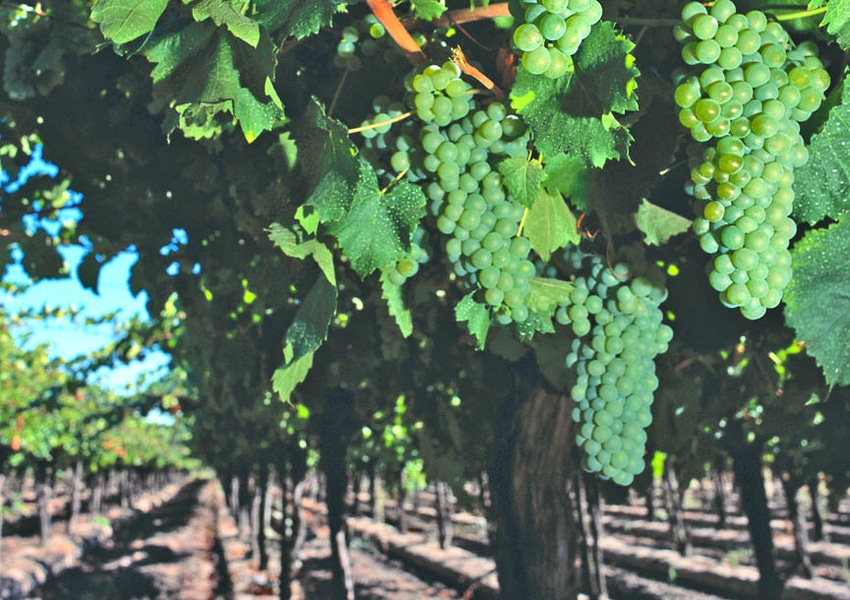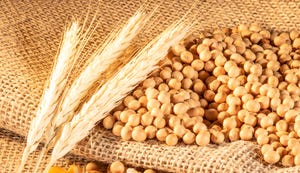December 11, 2013

Two key speakers at a Fresno symposium on wine grapes found much to agree upon when it came to decision making on the almonds-versus-grapes choice and the need for grape growers to hit a sustainable gross return.
“I agree with (Ben Slaughter, an Accredited Rural Appraiser with Correia-Xavier Inc. in Fresno) that wine grape growers have to have a $5,500 to $6,000 per acre gross to justify planting a vineyard,” said Nat DiBuduo, president and CEO of Allied Grape Growers.
DiBuduo, who pronounced the state of California’s wine grape industry “healthy, growing and stable,” said a second consecutive crop that will nearly match last year’s more than 4 million tons crushed is not excessive though it is 10 percent above the average crush.
Among his hopes is that the size of the 2012 and 2013 crops will keep down imports, which both he and Slaughter expect will continue to challenge California growers.
Slaughter’s take-home points
For now, nut crops are more likely to provide a better return than vineyards, but that could change as water scarcity drives up costs, given that grapevines require less water than almonds.
Moreover, a strengthening dollar could make imports more affordable and nuts less valuable.
DiBuduo said scarcity of water on the Central Valley’s West Side could have some play in the choice of which permanent crop to plant there: almonds or grapes.
Slaughter pointed out that expansion of the Panama Canal by 2015 could significantly change both the import and export picture for California commodities that include wine. It would open the canal to ships that can carry 12,000 to 15,000 containers, compared to ships that today pass through the canal carrying 3,000 to 5,000 containers.
Use of those bigger ships, he said, could be good for export crops that include almonds and bad for crops competing with imports, including Central Valley wine.
Slaughter said there were regions of the state where excess grape tonnage was turned away by wineries or lower prices were offered in 2013, including Sonoma, Lake and Mendocino Counties.
Regarding Napa and Sonoma, he said, “Those guys are fine.” As for the Paso Robles region, he said scarcity of water could limit planting of vineyards there.
DiBuduo said wine grapes are “in supply/demand balance.”
DiBuduo said Valley varieties most in demand are Cabernet Sauvignon, French Colombard and Chardonnay.
He does not foresee an immediate shortage of wine, expects the spot market to soften and doesn’t expect higher grape prices to slow sales, though they could cut into winery margins.
DiBuduo said a lower price for Thompson Seedless grapes sold for crushing this year -- $235 per ton compared to last year’s $325 per ton – was a result of premature speculation of a low raisin price and talk of a crop that was estimated at 12 tons per acre, when the average was closer to 10.25 tons.
Sweet sells
Here are some observations made during other presentations at the 2013 San Joaquin Valley Wine and Grape Industry Forum presented by the San Joaquin Valley Winegrowers Association:
• John Aguirre, president of the California Association of Winegrape Growers, talked of legislation that could pose challenges for growers.
Among those is the Food Safety Modernization Act. Aguirre believes wine grapes should be excluded from provisions of that act because they are a processed product distinct from, for example. table grapes.
“Grapes harvested for wine cannot be directed to the fresh market,” he said.
Both he and DiBuduo warned that the industry needs to continue to press its “sustainability” efforts to avoid directives that could be imposed by retailers out to put in place “key performance indicators.”
“If we don’t act, the Wal-Marts, Sam’s Clubs and Safeways will impose their own vision,” Aguirre warned.
On the state level, the association is pressing for changes in driver’s license legislation that covers undocumented workers. The current language identifies the licensed driver as undocumented.
• Alison Crowe, a consulting winemaker with Garnet Vineyards, said “sweet sells,” pointing to products that include Cinnamon Vodka.
“Winemakers are looking for spice box varietals,” she said, referring to an increase in red and white blends.
Crowe also talked of flash détente, a relatively new technique that involves “explodng grape cells under a vacuum” for color extracting and improvements in taste.
She said not having a facility allows her to be “mobile, very responsive.”
• Bob Torkelson, president and chief operation officer of Trinchero Family Estates, reiterated a theme of Crowe’s presentation: “Give the customers what they want.”
He also talked of efforts to build a $300 million winery and distribution building along Interstate 5 near Lodi, which would put the winery near the grape growing areas that are among Trinchero’s suppliers.
The company’s brands include Sutter Cellars, Ménage a Trios and Napa Cellars. It is the fourth largest wine company in the United States.
The company grows grapes in 10 California counties.
Torkelson said he is encouraged by the fact that preference for wine as the drink of choice has increased in the past 20 years among those 21 to 29 years old.
• Deborah Golino, director of Foundation Plant Services at the University of California at Davis, talked of the foundation’s efforts to ensure vines are free of diseases that can include red blotch.
She said use of new technologies is helping to do that, leading to vines “as squeaky clean as possible.”
A Cabernet Franc index is used to help detect red blotch, she said.
• Carson Smith, chairman of the San Joaquin Valley Winegrowers Association, presented two lifetime achievement awards.
They went to Jack Farrior, whose farming operations included Bacchus Farms and Farrior Farms, and to Marko Zaninovich, whose family operations are also active in the table grape business.
More from Western Farm Press
Gun control and agriculture clash over homemade pistol
About the Author(s)
You May Also Like




